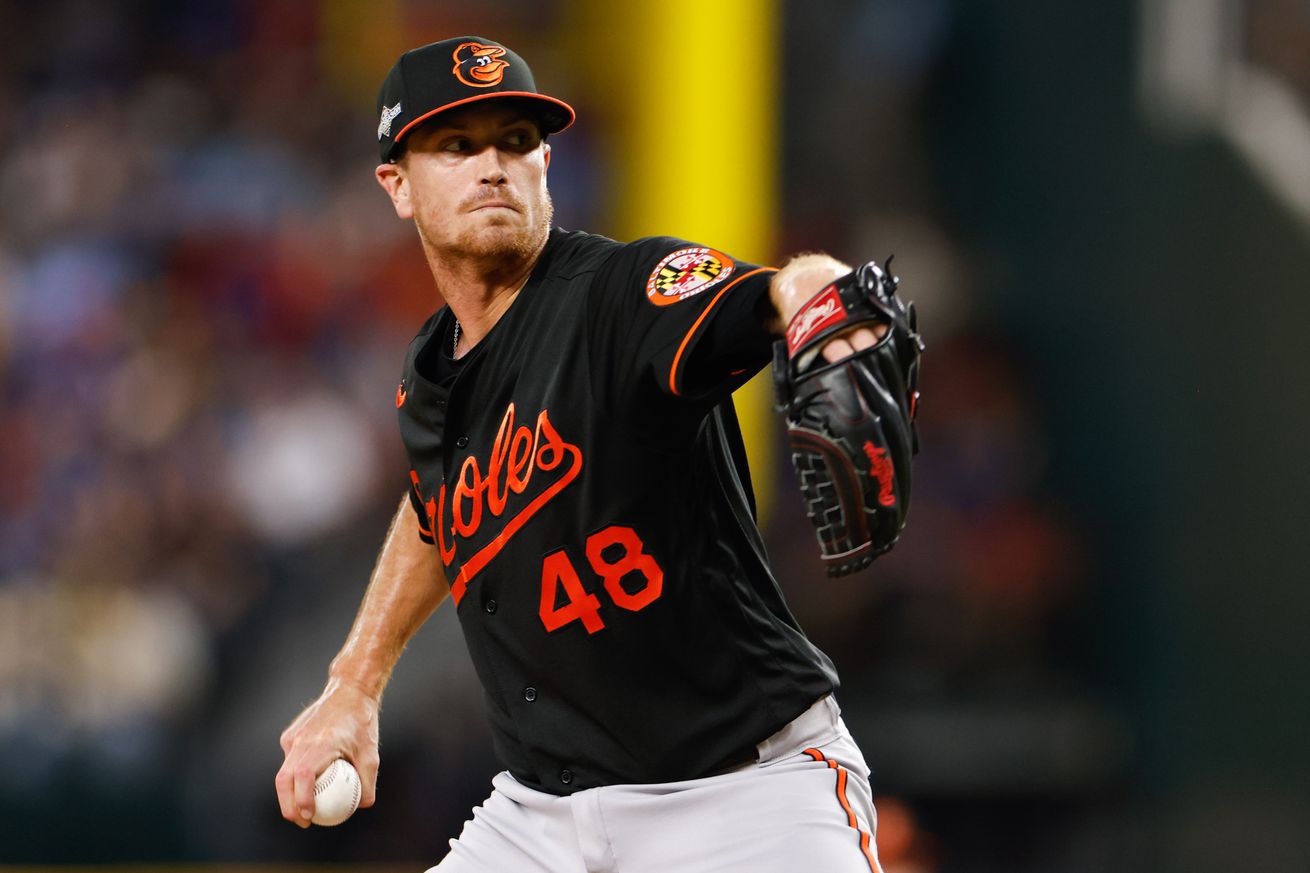
Is it stinginess or sentimentality that keeps drawing the Orioles to these guys?
You know, for a team that describes itself as “youthful” and “data-driven,” the Orioles sure do count on the leadership qualities of old veterans—especially starting pitchers—a lot. The latest move came last week, when the team announced they were signing 41-year-old starter Charlie Morton to a one-year, $15-million deal.
It was not a splashy move, in context. As Stacey recapped Monday, everywhere you look seems to be an MLB writer shaking their head at the Orioles’ “tepid offseason.” This winter, the Yankees have brought on the likes of lefty ace Max Fried, bullpen monster Devin Williams, outfielder and 2019 MVP Cody Bellinger, and seven-time All Star 1B Paul Goldschmidt. The O’s? Morton, oft-injured outfielder Tyler O’Neill, light-hitting backup catcher Gary Sánchez, and a 35-year-old Japanese ace who’s never pitched in the States, Tomoyuki Sugano.
Morton and Sugano fit a well-established pattern in Orioles rotation construction that you’d thought they’d maybe outgrow this offseason. Every year, O’s starters include a bunch of untested youth plus a late-addition veteran arm you wouldn’t want to call “over the hill,” but… you wouldn’t stop yourself from maybe thinking it. There are better and worse versions. Better: Kyle Gibson (2023), Jordan Lyles (2022). Worse: Matt Harvey (2021), Félix Hernández (2021). Best: Corbin Burnes (2024).
To be fair, Morton is a very good version of the now-clichéd “old-guy-with-playoff-experience-and-leadership-qualities” type, even given his age (41). With a 3.92 ERA and .248 batting average against in his last two seasons, he raises the floor of the O’s back end of the rotation. He’s a two-time All Star and has two World Series rings.
And he’s a paragon of durability, despite being the second-oldest player in the game after Justin Verlander. Over his last four seasons, Morton has made 30-plus starts, and has outpitched league-average twice (2021 – 130 ERA+, 2023 – 120 ERA+). Since 2017, he ranks fourth in MLB in strikeouts (1,417), eighth in innings (1,232.2), and 21st in ERA (3.64). All this approximately twelve years removed from Tommy John and eight years removed from a hamstring surgery that he thought at the time might end his career. As he told the O’s beat, he’s learned over the last ten years how to take care of himself, from diet to workouts to delivery. It’s impressive.
Morton knows the drill. Speaking recently about his decision not to retire, why he chose the O’s, and what he brings to the club, Morton offered that he wouldn’t force his opinions on youngsters “from some kind of pedestal,” but he believes he can build trust with his teammates, “have those conversations,” and eventually be a “clubhouse guy” who makes an impact.
As for Sugano, at 35, there are nothing like franchise-defining expectations on his shoulders, but he does have an impeccable pedigree in the NPB: in 12 seasons, he’s gone 136-74 with a 2.43 ERA and 1.031 WHIP. In 2024, he won Japan’s MVP award, too, going 15-3 with a 1.67 ERA and a ridiculous 2.6 percent walk rate—keep in mind, too, that Japan’s strike zone is even smaller than the American one, so the control should translate.
As he finally makes his leap to MLB, Sugano joins a crowd of high-risk, high-reward Japanese starters that has produced mixed results. For every Shohei Ohtani (fine, let’s leave him out of this, as he’s in his own category)—for every Yu Darvish, who’s made a strong impact over a long MLB career, there’s a Hideki Irabu or Daisuke Matsuzaka, who’ve burned out with injuries. In the middle, there are many Japanese pitching imports, too, who have turned out to be solid, if not spectacular: Kenta Maeda, Hisashi Iwakuma, Koji Uehara, Hiroki Kuroda. Sugano, with his sterling resume, could easily hit that level.
But is it enough? In 2022 or 2023, you’d have gratefully taken Morton and Sugano as team-building pieces. Now, for a team that’s trying to punch through the ceiling, it feels too late in their cycle to let an ace like Corbin Burnes walk and not replace him other than, as our John Beers pointed out, with a pair of low-cost gambles.
As it now stands, the rotation will involve some combination of Morton, Sugano, Grayson Rodriguez, Dean Kremer, Cade Povich, Zach Eflin, Albert Suárez, and, when he’s ready, hopefully by late spring or mid-summer, Kyle Bradish. It is, frankly, a lot of potential pitching options. Which makes sense, given how injury-wracked the O’s were last season. But is it enough to make them great? Jon Meoli considered that all the roster additions add up “to a team that, considering it has lost Burnes and Anthony Santander, may not be better than last year’s group but doesn’t feel like it’s going to be worse.”
You can’t help but feel that that’s not good enough, not with a new owner and a core of young talent. The Orioles have suggested that they’ll continue to add pitching, but they have not promised a multi-year deal on a top-of-the-line starter to replace Burnes. Quantity over quality just doesn’t inspire much confidence at this stage.
It’s not that this rotation couldn’t perform well and lead the O’s back to a deep run in the playoffs. But it’s the front office itself that raised expectations by telling us they were playing around in the same pool as other teams for Corbin Burnes, Max Fried, and other high-end starters. Moreover, expectations are somewhat self-fulfilling: an ownership group that’s willing to spend on a key last team-consolidating piece signals to fans that theirs is a winning team. To this point, the 2025 Orioles look too much like the teams of the last two seasons—solid playoff contenders, but ultimately too imperfect to contend for a championship.
